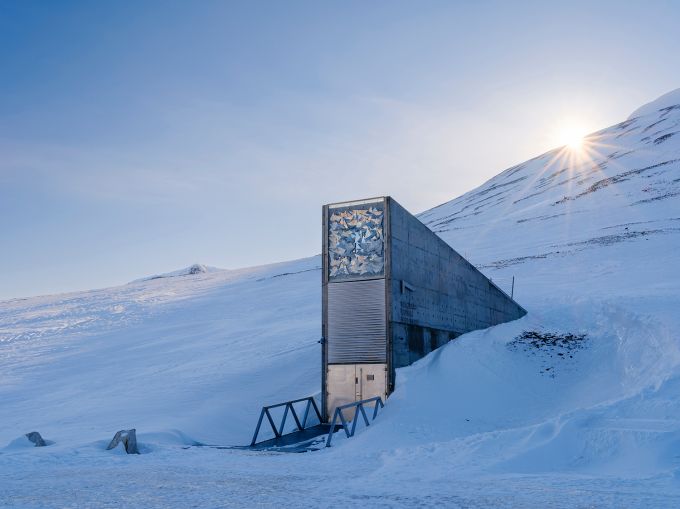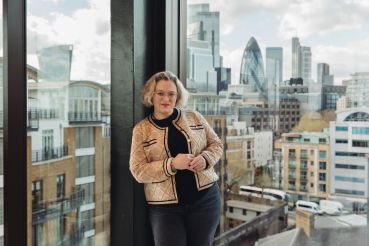Norway’s Global Seed Vault Steels Itself Against Climate Change
The secure vault at the top of the world safeguards 1.1 million seed varieties for the future
By Anna Staropoli November 29, 2023 9:00 am
reprints
Nestled in the mountains of the world’s northernmost community, one building braces for doomsday, both in design and function. The Norwegian archipelago of Svalbard — between continental Norway and the North Pole — houses the Svalbard Global Seed Vault, which stores and protects more than 1.1 million seed varieties from nearly every country.
In an area that’s home to more polar bears than people, the seed vault acts as a storage hub for humanity’s future, thanks to its Arctic-specific construction intended to weather worst-case scenarios. Before it can reach the world’s end however, the vault has to contend with the current climate. That means reckoning with warming temperatures.
Climate change has thawed much of the Arctic’s permafrost. Svalbard itself is heating six times faster than the global average, according to several studies, while the archipelago recently recorded its hottest temperatures ever: July averaged around 50 degrees Fahrenheit. That’s warm enough to forgo a coat, or at least to discard layers of clothing … in the Arctic.
Svalbard journalist Line Nagell Ylvisåker summarized the archipelago’s environmental state with the title of her book: “My World Is Melting.”
If Svalbard is melting, there may be immediate implications for its seeds, and the building that houses them. By design, both are more than equipped for disaster, given the vault’s inception as a doomsday backup.
“[Our] focus is on the role [the seed vault] plays in the long-term conservation of backup copies of the crop diversity the gene banks of the world currently hold and make available,” Luis Salazar, communications manager for the Global Crop Diversity Trust, told Commercial Observer via email. The international nonprofit co-manages the seed vault along with the Norwegian Ministry of Agriculture and the Nordic Genetic Research Center, known as NordGen.
The seed vault has the potential to ultimately store up to 4.5 million varieties of seeds, and as each seed packet contains approximately 500 seeds, a total of 2.5 billion can live in the vault at once. These are stored in boxes placed in the vault’s frigid chambers.
The government of Norway constructed and owns the vault, which opened in 2008. Construction began in 2006, but the seeds for the seed vault originated as early as the 1980s. A few questions spurred the building into being.
Namely: “How could we take care of seeds for the upcoming generation if something is going to happen?” said Hege Njaa Aschim, head of communications at Statsbygg, the Norwegian government’s building commissioner, property manager and developer. “How can we be sure that we have seeds for making food for the future, if it’s necessary?”
These questions directed the seed vault to the slope of Plateau Mountain outside of Longyearbyen near Svalbard’s airport, a short distance outside the city, said Njaa Aschim. The location means the vault remains isolated yet accessible, so new seeds can arrive and people can tend to them. The vault was carved 120 meters into solid rock, in a place suitable to dig into the mountain, added Njaa Aschim.
“You can see [the vault] from the city, but it’s very small and should be practical,” said Njaa Aschim. It’s also beautiful. “It looks like a shining, small diamond,” she said, thanks to the reflective turquoise design on the roof and front of the building. There’s also a neighboring service building made of steel.
It’s this location, in part, that distinguishes Svalbard’s seed vault from other gene banks. Across the globe, more than 1,750 gene banks exist with a focus on crop diversity. Svalbard’s ideal environment, however, serves as something of an insurance policy, according to the Global Crop Diversity Trust.
Thanks to its location at 78 degrees north latitude, Svalbard maintains the necessary Arctic conditions for the seed bank, as the seeds require cold storage to maintain their freshness. The vault consists of an underground tunnel that provides access to the seed chambers, the original design for which hinged on permafrost: the frozen layer of ground beneath the Earth’s surface. Permafrost typically consists of ice alongside rock or soil and tends to be typical of locations across the Arctic.
“[Long-term conservation] means making sure the cold rooms at the end of the tunnel are always at negative 18 degrees [Celsius], which provides the optimal conditions for seeds to last the longest in their dormant stage,” said Salazar. “It also means the seeds are secure. In a way, it’s like a huge refrigerator that holds — in one place — the largest collection of crop diversity ever.”
Black steel originally comprised the seed vault’s access tunnel, drawing material inspiration from other cold parts of the world like Alaska, said Njaa Aschim.
Permafrost was supposed to solidify around the tunnel and keep it in place. Yet, in 2016, Svalbard experienced unusually high temperatures and substantial rainfall, said Njaa Aschim. “It was very unusual,” she said. “It should be minus 10 degrees [Celsius].” Water seeped into the tunnel’s entrance in 2017, intruding the structure but stopping just before it reached the vault’s doors.
The incident — or rather the crisis, in the words of Njaa Aschim — resulted in the construction of a waterproof concrete tunnel that would prevent water from coming inside the vault. With the help of expert groups from all over the world, Statsbygg built a 45-meter access tunnel, layering icing pipes and mats between soil.
“We kind of helped build up a permafrost,” said Njaa Aschim, who noted that the seed vault’s surrounding permafrost is now in ordinary use. “But the tunnel is not dependent on the permafrost anymore; we are afraid that the nature or the climate will do something with permafrost in the long side, so we cannot depend on it anymore.”
Granted, threats to the building are not the same as threats to the seeds. The seed deposits remain deep within the permafrost and will likely remain safe for the future, experts told The Guardian at the time. “The water that seeped into the tunnel’s entrance was never a problem for the seeds,” said Salazar. “There was no risk at all.”
“Even inside the mountain, the cold rooms always needed a little help to keep the constant minus 18 temperature,” Salazar added. (The vault also uses artificial cooling mechanisms.) “The permafrost just makes it easier and less costly to keep that temperature. And, should the equipment malfunction, the permafrost — at minus 3, minus 5 — would keep the seeds alive for a long time.”
Despite a warming world — and the vault alterations — Svalbard’s environment continues to nurture the world’s seeds.
And, if the vault calls for careful, deliberate planning, so does everything else on the archipelago.
Buildings along the main road of Longyearbyen — practically the only road — are built on stilts, or piles, elevating everything from hotels to residences. Even the seed vault’s adjacent service building, constructed in 2018, sits on steel poles. When permafrost melts in the spring, the poles help stabilize the buildings.
Recently, the permafrost has been losing its cool. The temperature of the permafrost at a depth of 10 meters has risen 0.7 degrees Celsius per decade, MOSJ, Svalbard’s environmental monitoring system, reported in May 2022. That rise has also accelerated over the last 10 years.
These rising temperatures not only result in a faster decline of permafrost, but also feed back into warming temperatures. Melting Arctic permafrost releases greenhouse gases and therefore contributes to global warming, which, in turn, causes more permafrost to melt.
The problem of permafrost therefore breaches beyond the seed vault’s Plateau Mountain, with implications for the archipelago at large. Just as the seed vault’s design has evolved, Svalbard’s architecture has likewise shifted accordingly. New construction relies on steel piles, rather than the wooden piles used in older, traditional buildings. Those wood-supported buildings are more likely to rot and become unstable, whereas the steel is sturdier and tends to hold up when buried 15 meters into the ground, according to construction company Skanska.
“We experience that the good piles we have used until now [are] not good enough because the permafrost is not reliable in all of Svalbard,” said Njaa Aschim.
Beyond permafrost and climatic conditions, yet another factor jeopardizes the longevity of Svalbard’s seed vault. It has nothing to do with the physical building — and everything to do with who can access it. “People are heat sources,” said Njaa Aschim. “We can’t have anything inside. Just the seeds.”
To minimize extraneous heat, the Global Seed Vault no longer allows visitors to enter. In fact, everything that once occurred in the vault’s tunnel now happens in that neighboring service building.
Limitations on how visitors interact with sites focused on preservation are not unique to the seed vault, nor to seeds. In Padua, Italy, for example, the Scrovegni Chapel houses some of Giotto’s most famous frescoes. Rather than let visitors come and go, however, the chapel requires a minutes-long wait in an air-filtered room between the entrance and the chapel. Air filtration and controlled access creates a more stable microclimate that helps preserve the chapel’s ancient artwork.
Whether a building preserves painted scenes or seeds, future-thinking real estate doesn’t just address the physical space, but also encompasses how people interact with a location.
“I understand the interest for people, that they want to come to visit,” said Njaa Aschim. “But I think I’m glad we have gotten these strict rules. This is a necessity for [ensuring we] have something to lean on if the worst thing should happen in the world.”
That’s not to say the seed vault remains entirely inaccessible. If someone truly wants to visit, they can hike to the building’s exterior, so long as they plan accordingly. The vault sits beyond Longyearbyen’s designated safe zone. Turn left at the end of that main street, and soon you’ll pass a sign — a warning, rather — adorned with a polar bear decal. Once you see that sign, make sure you’ve rented a gun or hired a guide who carries one: paw prints have been spotted along the mountain.
Despite the prevalence of polar bears, the worst threat to the seed vault doesn’t come in the form of apex predators nor those changing Arctic conditions. Rather, human beings likely present the most significant risks, said Njaa Aschim, who pinpointed terror attacks as a greater danger than climbing temperatures. The seed vault utilizes 24/7 surveillance cameras and security precautions.
“It’s quite safe in there,” said Njaa Aschim, “even from climate change.”


